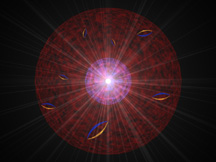 Purdue News
Purdue News
 Purdue News
Purdue News

|
"Science and engineering students have learned for years that the electron has a constant electronic strength, but now we've seen that this may not be the case," says David Koltick, professor of physics at Purdue.
Koltick says his research shows that the electromagnetic force from the electron, or its electronic strength, may increase toward the particle's central core.
According to his data, surrounding the electron's core is a fuzzy "cloud" of virtual particles, which wink in and out of existence in pairs. One particle in the pair is positively charged, the other negatively charged.
The cloud is polarized, which means that the strong negative charge at the core "pushes" the negatively charged particle in a pair slightly farther away from the core than the positively charged particle. The polarization is strongest toward the center of the could.
The polarized pairs essentially cancel each other out so that they do not "add" any net electric charge to the electron, Koltick says, but the cloud plays a key role in how we perceive the electromagnetic force from the electron.
"The cloud of virtual particles acts like a screen or curtain that shields the true value of the central core," Koltick explains. "As we probe into the cloud, getting closer and closer to the core charge, we 'see' less of the shielding effect and more of the core. This means that the electromagnetic force from the electron as a whole is not constant, but rather gets stronger as we go through the cloud and get closer to the core.
"Ordinarily when we look at or study an electron it is from far away and we don't realize the core is being shielded. We are the first researchers to actually measure this effect."
Koltick's results appeared in the Jan. 20 issue of the journal Physical Review Letters.
Koltick and his colleagues also determined that the strong nuclear force, which is the "glue" that holds together elementary particles such as protons, gets weaker closer to the core charge. Other researchers also have seen this effect in the strong force.
"Because the electromagnetic charge is in effect becoming stronger as we get closer and the strong force is getting weaker, there is a possibility that these two forces may at some energy be equal," Koltick says. "Many physicists have speculated that when and if this is determined, an entirely new and unique physics may be discovered."
To obtain their results, Koltick and more than 50 colleagues, including Purdue physics Professor Edward Shibata and former doctoral students Barry Howell and Ilan Levine, collided very-high-speed beams of particles at a facility at the Japanese Laboratory for High Energy Physics.
Source: David Koltick, (765) 494-5557; e-mail, koltick@physics.purdue.edu
Purdue News Service: (765) 494-2096; e-mail, purduenews@purdue.edu
NOTE TO JOURNALISTS: A copy of the scientific paper also is available. Also, copies of the scientific paper are available from Purdue News Service.
Photo Caption:
According to recent measurements made by Purdue physicists, an electron may not be
a simple point charge, as previously thought. Instead, the particle may be thought
of as being at the center of a fuzzy "cloud," as in this artist's conception, where
the electromagnetic force increases toward a central core. The "cloud" consists of virtual
particles, which wink in and out of existence in pairs -- one particle positively
charged (blue), the other negatively charged (yellow). (Graphic courtesy Dennis Harp,
Purdue Physics Department.)
Color graphic, electronic transmission, and Web and ftp download available. Photo
ID: Koltick/Electron
Download here